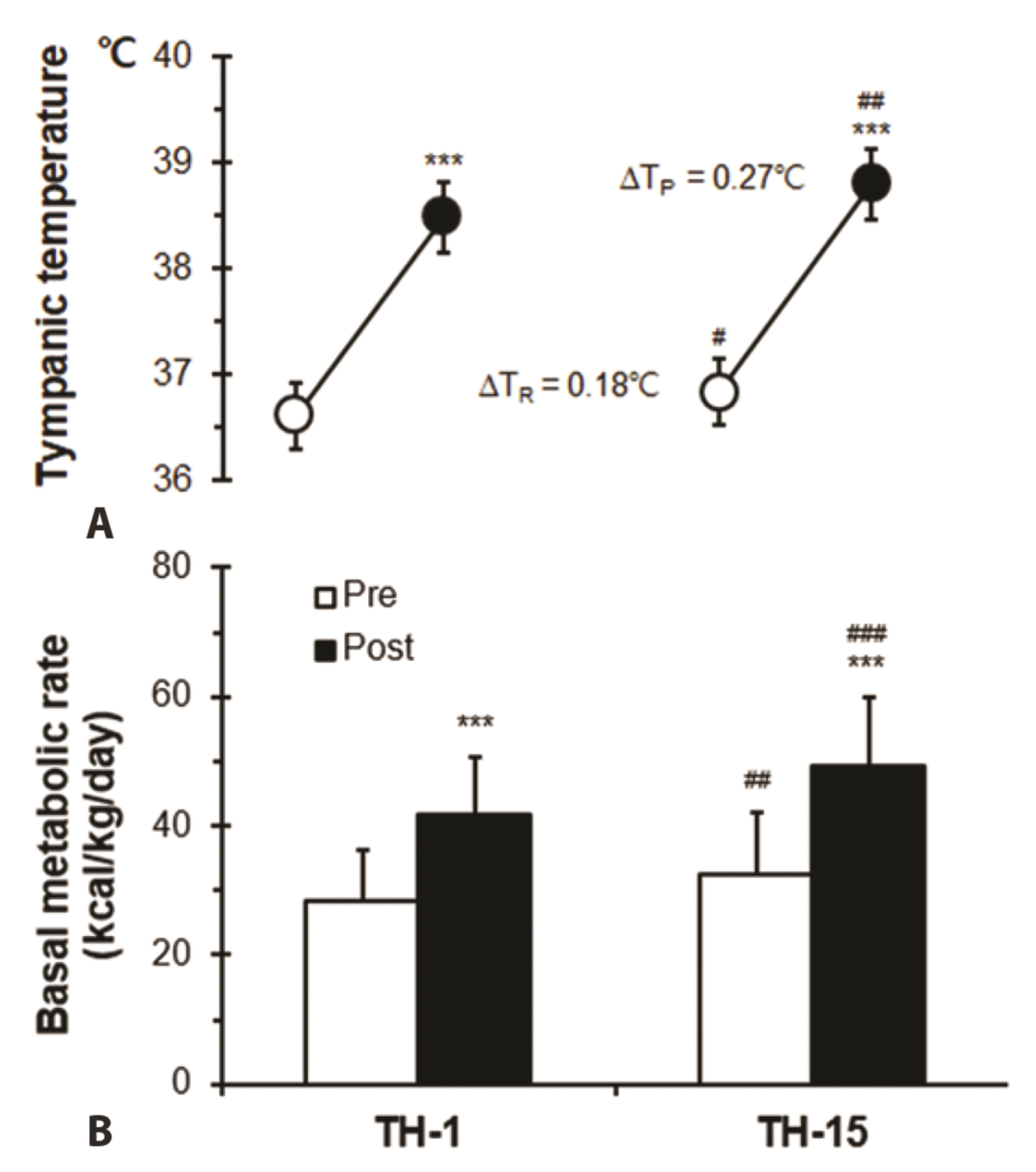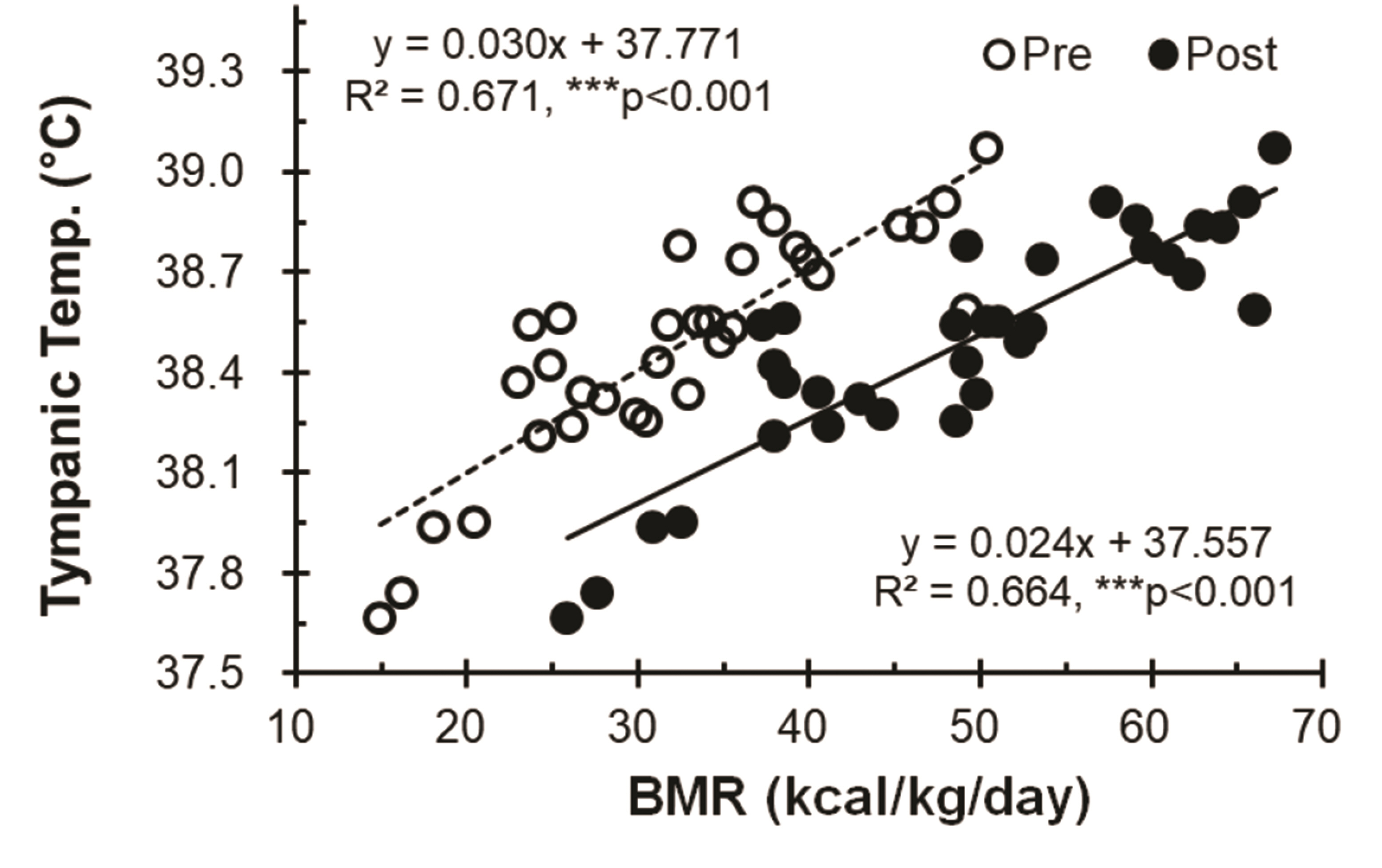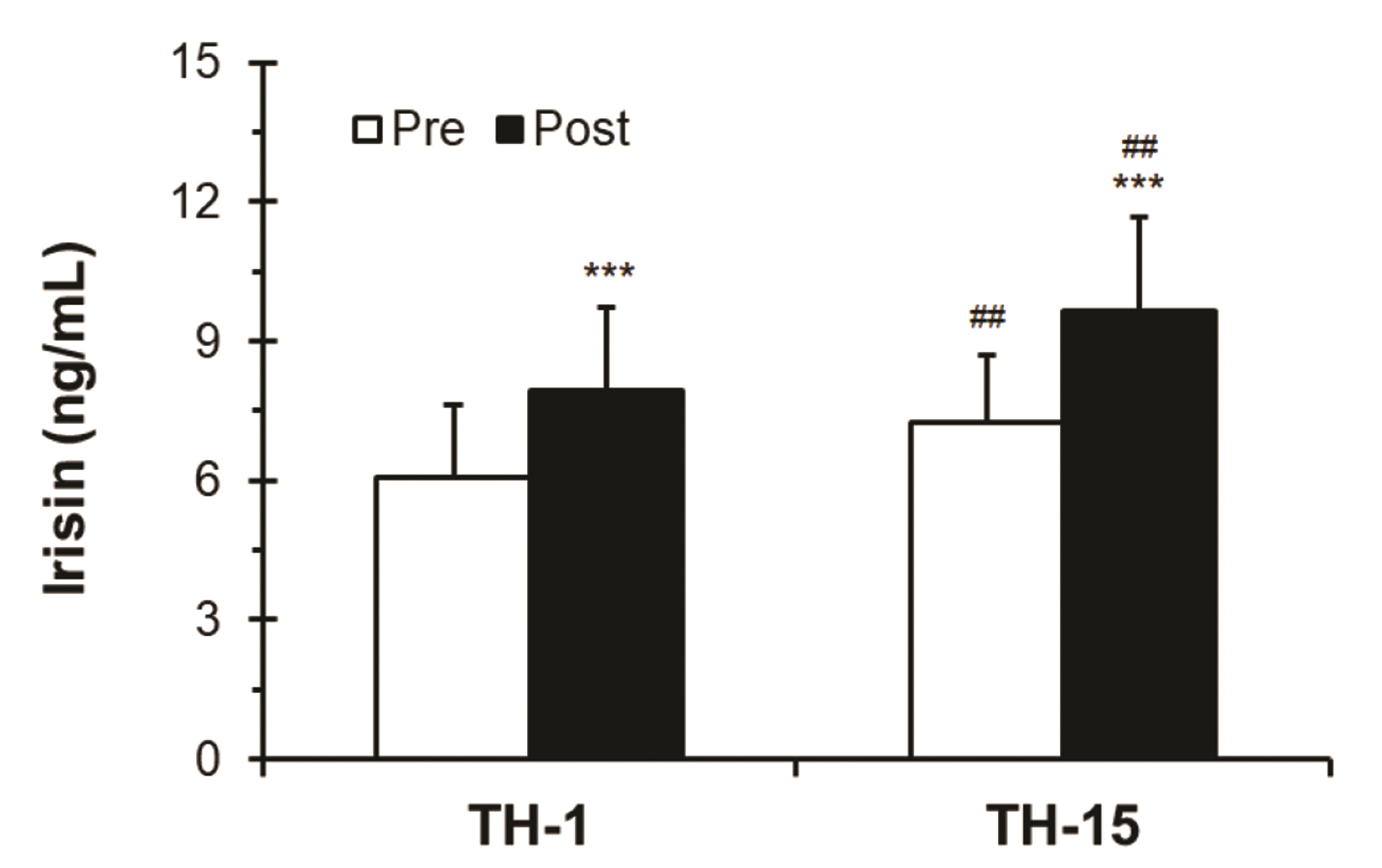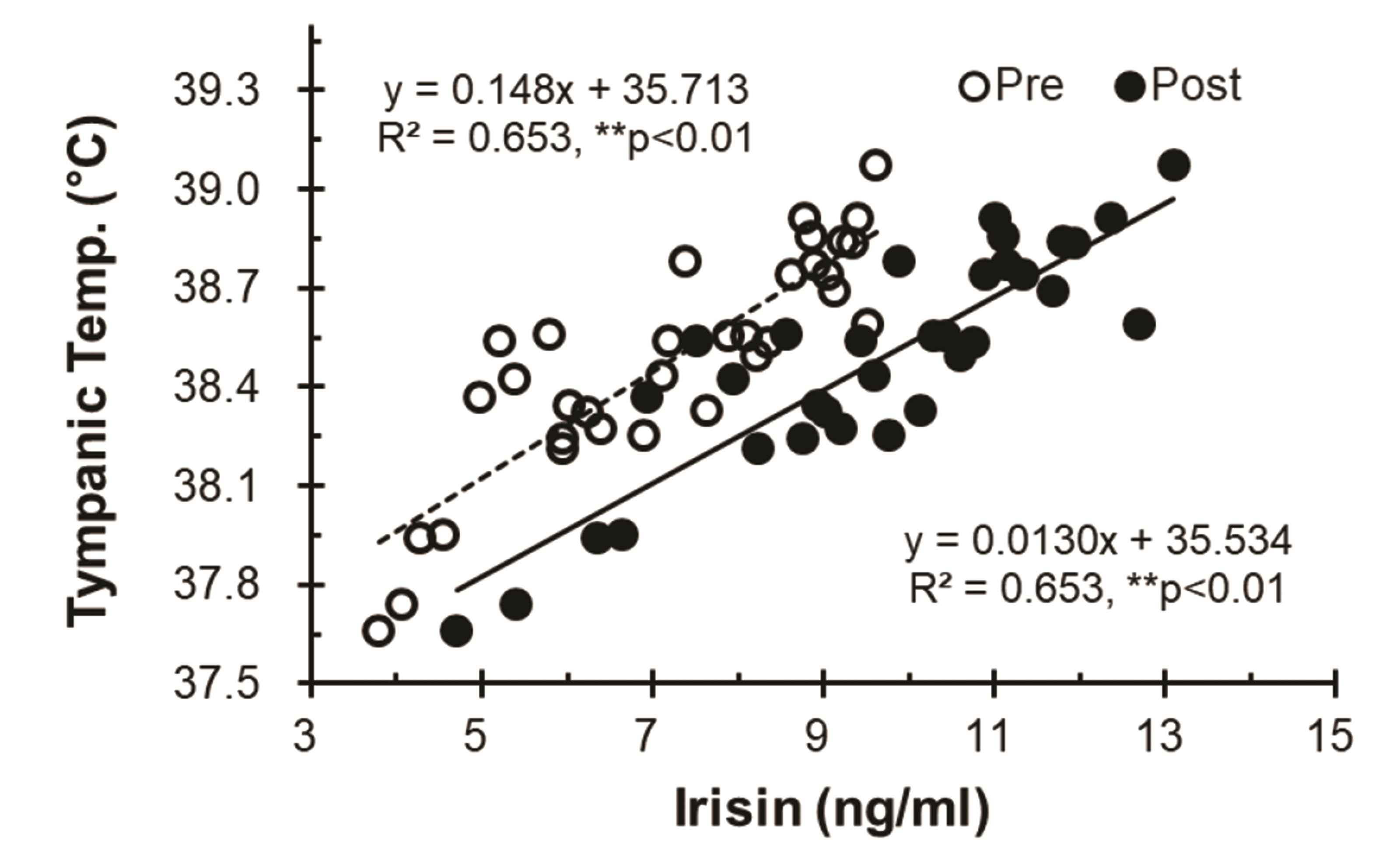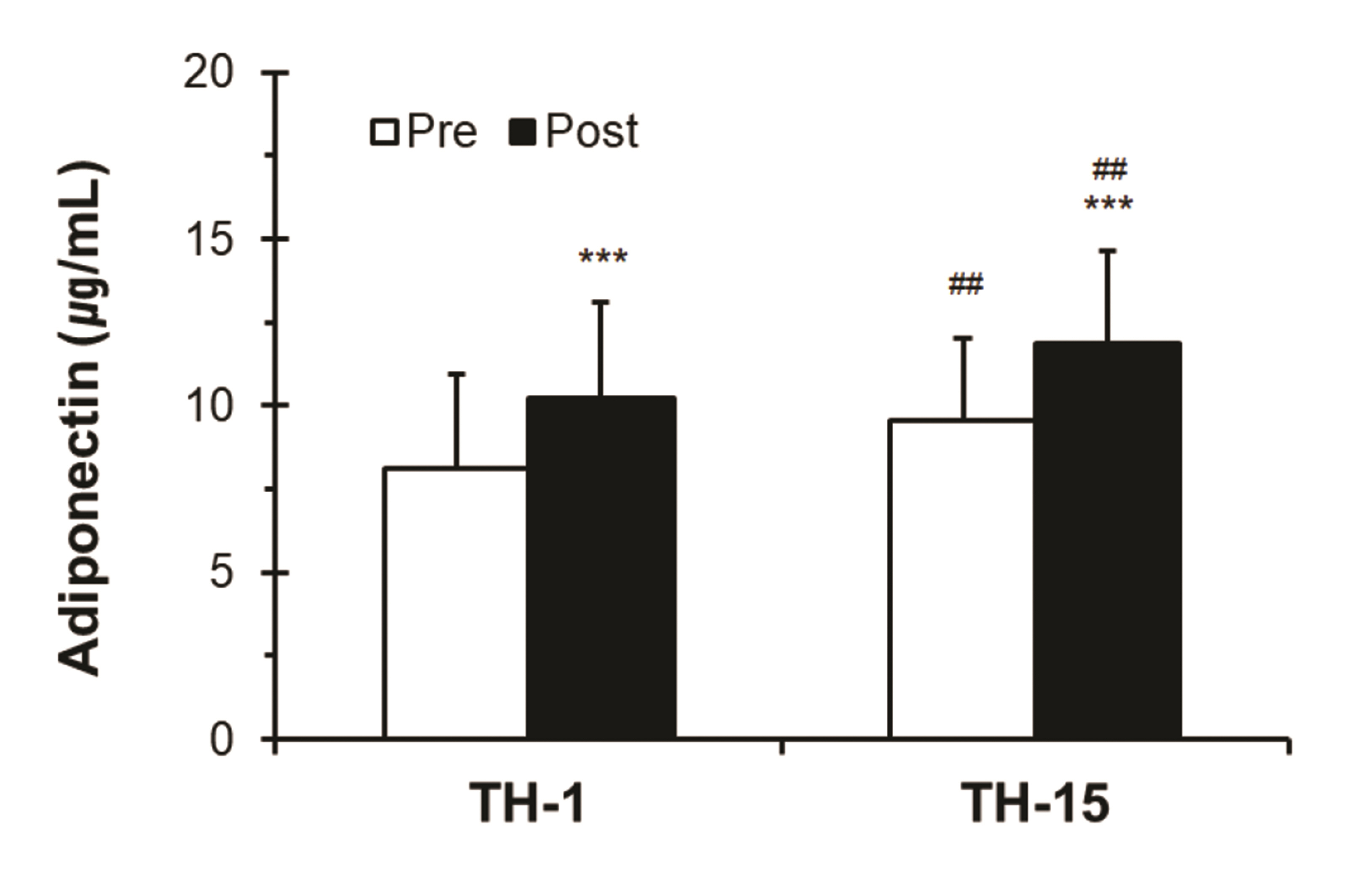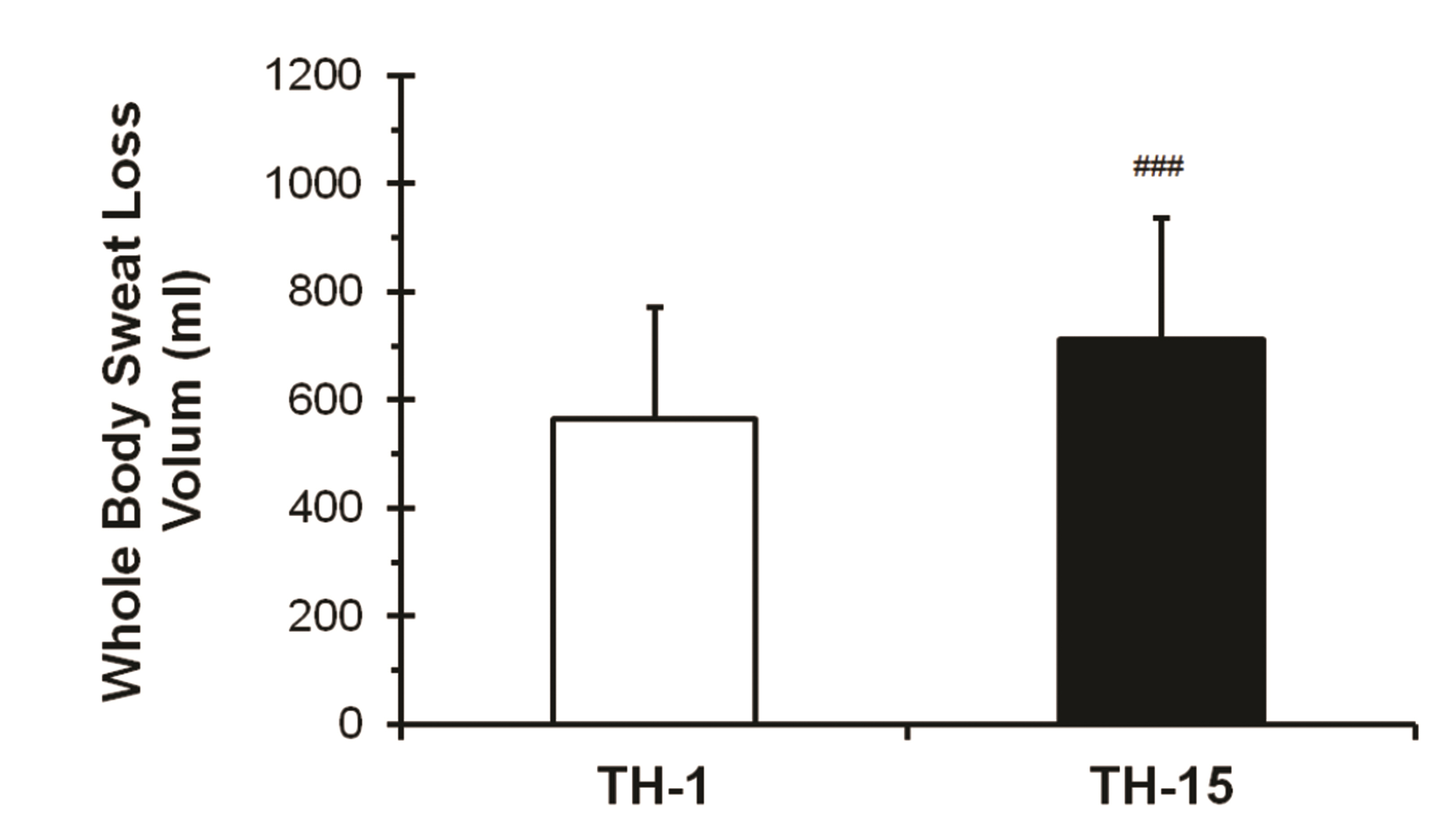Korean J Physiol Pharmacol.
2022 Nov;26(6):501-509. 10.4196/kjpp.2022.26.6.501.
Thermotherapy as an alternative to exercise for metabolic health in obese postmenopausal women: focus on circulating irisin level
- Affiliations
-
- 1Department of Physiology, College of Medicine, Soonchunhyang University, Cheonan 31151, Korea
- 2Department of Medical Sciences, Soonchunhyang University, Asan 31238, Korea
- 3Department of Occupational and Environmental Medicine, Soonchunhyang University Cheonan Hospital, Cheonan 31151, Korea
- KMID: 2534525
- DOI: http://doi.org/10.4196/kjpp.2022.26.6.501
Abstract
- Irisin is a myokine caused by exercise that improves insulin resistance and weight loss. However, under unfavorable conditions such as air pollution, and during the pandemic, outdoor activities are uncomfortable. Therefore, in this study, the effect of heat therapy (half bath 42 ± 0.5°C for 30 min) on irisin circulation levels as an exercise alternative for middle-aged obese women after menopause was investigated. Subjects were 33 women aged 49.54 ± 6.04 years, with parameters of height, 160.12 ± 4.33 cm, weight, 69.71 ± 7.52 kg, body surface area 1.73 ± 0.13 m2 , body mass index, 27.19 ± 3.40 kg/m2 . The results suggest that circulating irisin levels showed a significant increase after one-time thermotherapy (TH-1). However, the increase in circulating irisin levels after 15 treatments (TH-15, 5 days/week, 3 weeks) was significantly varied. The level of adiponectin, which increases fatty oxidation to reduce fatty deposition, increased significantly at TH-1, but further increased at TH-15, which was significantly different from the level of TH-1. In addition, the basic serum free fatty acid (FFA) level was significantly increased at TH-15 compared to TH-1. Significant differences were also found in the lipid profile (body mass index, waist circumference, and % body fat). Thermotherapy can significantly increase the tympanic temperature and induce changes in circulating irisin and adiponectin levels. Thus, it resulted in positive changes in FFA and lipid profiles. Therefore, repeated thermotherapy is effective in increasing circulating irisin levels in postmenopausal obese women.
Keyword
Figure
Reference
-
1. Yang HJ, Suh PS, Kim SJ, Lee SY. 2015; Effects of smoking on menopausal age: results from the Korea National Health and Nutrition Examination Survey, 2007 to 2012. J Prev Med Public Health. 48:216–224. DOI: 10.3961/jpmph.15.021. PMID: 26265667. PMCID: PMC4542296. PMID: https://www.scopus.com/inward/record.uri?partnerID=HzOxMe3b&scp=84938827154&origin=inward.
Article2. Amiri P, Deihim T, Nakhoda K, Hasheminia M, Montazeri A, Azizi F. 2014; Metabolic syndrome and health-related quality of life in reproductive age and post-menopausal women: Tehran Lipid and Glucose Study. Arch Iran Med. 17:423–428. PMID: 24916528. PMID: https://www.scopus.com/inward/record.uri?partnerID=HzOxMe3b&scp=84902526881&origin=inward.3. Nappi RE, Palacios S. 2014; Impact of vulvovaginal atrophy on sexual health and quality of life at postmenopause. Climacteric. 17:3–9. DOI: 10.3109/13697137.2013.871696. PMID: 24423885. PMID: https://www.scopus.com/inward/record.uri?partnerID=HzOxMe3b&scp=84892737699&origin=inward.
Article4. Goh VHH, Hart WG. 2018; Excess fat in the abdomen but not general obesity is associated with poorer metabolic and cardiovascular health in premenopausal and postmenopausal Asian women. Maturitas. 107:33–38. DOI: 10.1016/j.maturitas.2017.10.002. PMID: 29169577. PMID: https://www.scopus.com/inward/record.uri?partnerID=HzOxMe3b&scp=85030837752&origin=inward.
Article5. Wulan SN, Westerterp KR, Plasqui G. 2010; Ethnic differences in body composition and the associated metabolic profile: a comparative study between Asians and Caucasians. Maturitas. 65:315–319. DOI: 10.1016/j.maturitas.2009.12.012. PMID: 20079586. PMID: https://www.scopus.com/inward/record.uri?partnerID=HzOxMe3b&scp=77649180244&origin=inward.
Article6. Mauvais-Jarvis F, Clegg DJ, Hevener AL. 2013; The role of estrogens in control of energy balance and glucose homeostasis. Endocr Rev. 34:309–338. DOI: 10.1210/er.2012-1055. PMID: 23460719. PMCID: PMC3660717. PMID: https://www.scopus.com/inward/record.uri?partnerID=HzOxMe3b&scp=84878632677&origin=inward.
Article7. Palmisano BT, Zhu L, Eckel RH, Stafford JM. 2018; Sex differences in lipid and lipoprotein metabolism. Mol Metab. 15:45–55. DOI: 10.1016/j.molmet.2018.05.008. PMID: 29858147. PMCID: PMC6066747. PMID: https://www.scopus.com/inward/record.uri?partnerID=HzOxMe3b&scp=85047506095&origin=inward.
Article8. Boström P, Wu J, Jedrychowski MP, Korde A, Ye L, Lo JC, Rasbach KA, Boström EA, Choi JH, Long JZ, Kajimura S, Zingaretti MC, Vind BF, Tu H, Cinti S, Højlund K, Gygi SP, Spiegelman BM. 2012; A PGC1-α-dependent myokine that drives brown-fat-like development of white fat and thermogenesis. Nature. 481:463–468. DOI: 10.1038/nature10777. PMID: 22237023. PMCID: PMC3522098. PMID: https://www.scopus.com/inward/record.uri?partnerID=HzOxMe3b&scp=84862776702&origin=inward.
Article9. Rodríguez A, Becerril S, Ezquerro S, Méndez-Giménez L, Frühbeck G. 2017; Crosstalk between adipokines and myokines in fat browning. Acta Physiol (Oxf). 219:362–381. DOI: 10.1111/apha.12686. PMID: 27040995. PMID: https://www.scopus.com/inward/record.uri?partnerID=HzOxMe3b&scp=85010850003&origin=inward.
Article10. Miyamoto-Mikami E, Sato K, Kurihara T, Hasegawa N, Fujie S, Fujita S, Sanada K, Hamaoka T, Tabata I, Iemitsu M. 2015; Endurance training-induced increase in circulating irisin levels is associated with reduction of abdominal visceral fat in middle-aged and older adults. PLoS One. 10:e0120354. DOI: 10.1371/journal.pone.0120354. PMID: 25793753. PMCID: PMC4368602. PMID: https://www.scopus.com/inward/record.uri?partnerID=HzOxMe3b&scp=84925779021&origin=inward.
Article11. Park TH, Lee HJ, Lee JB. 2021; Effect of heat stimulation on circulating irisin in humans. Front Physiol. 12:675377. DOI: 10.3389/fphys.2021.675377. PMID: 34262475. PMCID: PMC8273865. PMID: 6976cbe75b804346b69b026449b67bbc. PMID: https://www.scopus.com/inward/record.uri?partnerID=HzOxMe3b&scp=85109879766&origin=inward.
Article12. Wenger CB. 1972; Heat of evaporation of sweat: thermodynamic considerations. J Appl Physiol. 32:456–459. DOI: 10.1152/jappl.1972.32.4.456. PMID: 5026491. PMID: https://www.scopus.com/inward/record.uri?partnerID=HzOxMe3b&scp=0015324876&origin=inward.
Article13. Sawka MN, Leon LR, Montain SJ, Sonna LA. 2011; Integrated physiological mechanisms of exercise performance, adaptation, and maladaptation to heat stress. Compr Physiol. 1:1883–1928. DOI: 10.1002/cphy.c100082. PMID: 23733692. PMID: https://www.scopus.com/inward/record.uri?partnerID=HzOxMe3b&scp=84857658040&origin=inward.
Article14. Baker LB. 2017; Sweating rate and sweat sodium concentration in athletes: a review of methodology and intra/interindividual variability. Sports Med. 47(Suppl 1):111–128. DOI: 10.1007/s40279-017-0691-5. PMID: 28332116. PMCID: PMC5371639. PMID: https://www.scopus.com/inward/record.uri?partnerID=HzOxMe3b&scp=85015929812&origin=inward.
Article15. de Araújo AL, Silva LC, Fernandes JR, Benard G. 2013; Preventing or reversing immunosenescence: can exercise be an immunotherapy? Immunotherapy. 5:879–893. DOI: 10.2217/imt.13.77. PMID: 23902557. PMID: https://www.scopus.com/inward/record.uri?partnerID=HzOxMe3b&scp=84881290703&origin=inward.
Article16. Baker A, Sirois-Leclerc H, Tulloch H. 2016; The impact of long-term physical activity interventions for overweight/obese postmenopausal women on adiposity indicators, physical capacity, and mental health outcomes: a systematic review. J Obes. 2016:6169890. DOI: 10.1155/2016/6169890. PMID: 27293882. PMCID: PMC4884891. PMID: https://www.scopus.com/inward/record.uri?partnerID=HzOxMe3b&scp=84973364653&origin=inward.
Article17. Wendling ZA, Emerson JW, Esty DC, Levy MA, de Sherbinin A. 2018. 2018 Environmental performance index. Yale Center for Environmental Law & Policy;New Haven: https://epi.yale.edu/downloads/epi2018reportv06191901.pdf. DOI: 10.2217/imt.13.77. PMID: https://www.scopus.com/inward/record.uri?partnerID=HzOxMe3b&scp=84881290703&origin=inward.18. Zhou M, Liu Y, Wang L, Kuang X, Xu X, Kan H. 2014; Particulate air pollution and mortality in a cohort of Chinese men. Environ Pollut. 186:1–6. DOI: 10.1016/j.envpol.2013.11.010. PMID: 24333659. PMID: https://www.scopus.com/inward/record.uri?partnerID=HzOxMe3b&scp=84890191832&origin=inward.
Article19. AirKorea. Fine dust [Internet]. AirKorea;Incheon: Available from: https://www.airkorea.or.kr/web/pmWarning?pMENU_NO=115. cited 2020 Jul 1.20. Ritz B, Hoffmann B, Peters A. 2019; The effects of fine dust, ozone, and nitrogen dioxide on health. Dtsch Arztebl Int. 51-52:881–886. DOI: 10.3238/arztebl.2019.0881. PMID: 31941576. PMCID: PMC6976917. PMID: https://www.scopus.com/inward/record.uri?partnerID=HzOxMe3b&scp=85077941113&origin=inward.
Article21. Easterling DR, Meehl GA, Parmesan C, Changnon SA, Karl TR, Mearns LO. 2000; Climate extremes: observations, modeling, and impacts. Science. 289:2068–2074. DOI: 10.1126/science.289.5487.2068. PMID: 11000103. PMID: https://www.scopus.com/inward/record.uri?partnerID=HzOxMe3b&scp=0034703308&origin=inward.
Article22. Meehl GA, Tebaldi C. 2004; More intense, more frequent, and longer lasting heat waves in the 21st century. Science. 305:994–997. DOI: 10.1126/science.1098704. PMID: 15310900. PMID: https://www.scopus.com/inward/record.uri?partnerID=HzOxMe3b&scp=4043154304&origin=inward.
Article23. Slezakova K, Pereira MC, Morais S. 2020; Ultrafine particles: levels in ambient air during outdoor sport activities. Environ Pollut. 258:113648. DOI: 10.1016/j.envpol.2019.113648. PMID: 31806467. PMID: https://www.scopus.com/inward/record.uri?partnerID=HzOxMe3b&scp=85076231069&origin=inward.
Article24. Lee JB, Kim TW, Min YK, Yang HM. 2013; Seasonal acclimatization to the hot summer over 60 days in the Republic of Korea suppresses sweating sensitivity during passive heating. J Therm Biol. 38:294–299. https://doi.org/10.1016/j.jtherbio.2013.03.006. DOI: 10.1016/j.jtherbio.2013.03.006. PMID: https://www.scopus.com/inward/record.uri?partnerID=HzOxMe3b&scp=84877023854&origin=inward.
Article25. Shin YO, Lee JB, Min YK, Yang HM. 2013; Heat acclimation affects circulating levels of prostaglandin E2, COX-2 and orexin in humans. Neurosci Lett. 542:17–20. DOI: 10.1016/j.neulet.2013.03.017. PMID: 23523649. PMID: https://www.scopus.com/inward/record.uri?partnerID=HzOxMe3b&scp=84876744845&origin=inward.
Article26. Lee J, Shin Y. 2017; Comparison of density and output of sweat gland in tropical Africans and temperate Koreans. Auton Neurosci. 205:67–71. DOI: 10.1016/j.autneu.2017.05.004. PMID: 28506659. PMID: https://www.scopus.com/inward/record.uri?partnerID=HzOxMe3b&scp=85019094091&origin=inward.
Article27. Lee JB, Kim JH. 2018; Decreased thermal sweating of central sudomotor mechanism in African and Korean men. Am J Hum Biol. 30:e23091. DOI: 10.1002/ajhb.23091. PMID: 29341311. PMID: https://www.scopus.com/inward/record.uri?partnerID=HzOxMe3b&scp=85047994485&origin=inward.
Article28. Ramanathan NL. 1964; A new weighting system for mean surface temperature of the human body. J Appl Physiol. 19:531–533. DOI: 10.1152/jappl.1964.19.3.531. PMID: 14173555. PMID: https://www.scopus.com/inward/record.uri?partnerID=HzOxMe3b&scp=14944349971&origin=inward.
Article29. Sugenoya J, Ogawa T. 1985; Characteristics of central sudomotor mechanism estimated by frequency of sweat expulsions. Jpn J Physiol. 35:783–794. DOI: 10.2170/jjphysiol.35.783. PMID: 4079134. PMID: https://www.scopus.com/inward/record.uri?partnerID=HzOxMe3b&scp=0022394986&origin=inward.
Article30. Kim TW, Lee JB. 2013; The effects of caffeine ingestion before passive heat loading on serum leptin levels in humans. Appl Biochem Biotechnol. 171:1253–1261. DOI: 10.1007/s12010-013-0296-x. PMID: 23709289. PMID: https://www.scopus.com/inward/record.uri?partnerID=HzOxMe3b&scp=84888129274&origin=inward.
Article31. Lee JB, Kim TW. 2015; Increased levels of FFA during passive heat loading after a 2-week repeated heat load in Koreans. Int J Biometeorol. 59:473–475. DOI: 10.1007/s00484-014-0849-x. PMID: 24865598. PMID: https://www.scopus.com/inward/record.uri?partnerID=HzOxMe3b&scp=84939895547&origin=inward.
Article32. Kim TW, Shin YO, Lee JB, Min YK, Yang HM. 2010; Effect of caffeine on the metabolic responses of lipolysis and activated sweat gland density in human during physical activity. Food Sci Biotechnol. 19:1077–1081. https://link.springer.com/article/10.1007/s10068-010-0151-6. DOI: 10.1007/s10068-010-0151-6. PMID: https://www.scopus.com/inward/record.uri?partnerID=HzOxMe3b&scp=79957650578&origin=inward.
Article33. Weir JB. 1949; New methods for calculating metabolic rate with special reference to protein metabolism. J Physiol. 109:1–9. DOI: 10.1113/jphysiol.1949.sp004363. PMID: 15394301. PMCID: PMC1392602. PMID: https://www.scopus.com/inward/record.uri?partnerID=HzOxMe3b&scp=8944256349&origin=inward.
Article34. Lee JB, Kim TW. 2014; Passive heat loading links lipolysis and regulation of fibroblast growth factor-21 in humans. J Therm Biol. 45:163–167. DOI: 10.1016/j.jtherbio.2014.09.004. PMID: 25436966. PMID: https://www.scopus.com/inward/record.uri?partnerID=HzOxMe3b&scp=84907553418&origin=inward.
Article35. Pörtner HO. 2001; Climate change and temperature-dependent biogeography: oxygen limitation of thermal tolerance in animals. Naturwissenschaften. 88:137–146. DOI: 10.1007/s001140100216. PMID: 11480701. PMID: https://www.scopus.com/inward/record.uri?partnerID=HzOxMe3b&scp=0034978152&origin=inward.
Article36. Samy DM, Ismail CA, Nassra RA. 2015; Circulating irisin concentrations in rat models of thyroid dysfunction -- effect of exercise. Metabolism. 64:804–813. DOI: 10.1016/j.metabol.2015.01.001. PMID: 25720940. PMID: https://www.scopus.com/inward/record.uri?partnerID=HzOxMe3b&scp=84929654073&origin=inward.
Article37. Kim KH, Kim SH, Min YK, Yang HM, Lee JB, Lee MS. 2013; Acute exercise induces FGF21 expression in mice and in healthy humans. PLoS One. 8:e63517. DOI: 10.1371/journal.pone.0063517. PMID: 23667629. PMCID: PMC3646740. PMID: c6eb509b4526482e856d21e796d282c2. PMID: https://www.scopus.com/inward/record.uri?partnerID=HzOxMe3b&scp=84877149547&origin=inward.
Article38. Brindley RL, Bauer MB, Blakely RD, Currie KPM. 2017; Serotonin and serotonin transporters in the adrenal medulla: a potential hub for modulation of the sympathetic stress response. ACS Chem Neurosci. 8:943–954. DOI: 10.1021/acschemneuro.7b00026. PMID: 28406285. PMCID: PMC5541362. PMID: https://www.scopus.com/inward/record.uri?partnerID=HzOxMe3b&scp=85019610825&origin=inward.
Article39. Sternfeld B, Wang H, Quesenberry CP Jr, Abrams B, Everson-Rose SA, Greendale GA, Matthews KA, Torrens JI, Sowers M. 2004; Physical activity and changes in weight and waist circumference in midlife women: findings from the Study of Women's Health Across the Nation. Am J Epidemiol. 160:912–922. DOI: 10.1093/aje/kwh299. PMID: 15496544. PMID: https://www.scopus.com/inward/record.uri?partnerID=HzOxMe3b&scp=7244253095&origin=inward.
Article40. Karakelides H, Nair KS. 2005; Sarcopenia of aging and its metabolic impact. Curr Top Dev Biol. 68:123–148. DOI: 10.1016/S0070-2153(05)68005-2. PMID: 16124998. PMID: https://www.scopus.com/inward/record.uri?partnerID=HzOxMe3b&scp=25144501166&origin=inward.
Article41. Kuk JL, Saunders TJ, Davidson LE, Ross R. 2009; Age-related changes in total and regional fat distribution. Ageing Res Rev. 8:339–348. DOI: 10.1016/j.arr.2009.06.001. PMID: 19576300. PMID: https://www.scopus.com/inward/record.uri?partnerID=HzOxMe3b&scp=69049093712&origin=inward.
Article42. Ahima RS, Flier JS. 2000; Adipose tissue as an endocrine organ. Trends Endocrinol Metab. 11:327–332. DOI: 10.1016/S1043-2760(00)00301-5. PMID: 10996528. PMID: https://www.scopus.com/inward/record.uri?partnerID=HzOxMe3b&scp=0033789518&origin=inward.
Article43. Fang H, Judd RL. 2018; Adiponectin regulation and function. Compr Physiol. 8:1031–1063. DOI: 10.1002/cphy.c170046. PMID: 29978896. PMID: https://www.scopus.com/inward/record.uri?partnerID=HzOxMe3b&scp=85050621609&origin=inward.
Article44. Esposito K, Pontillo A, Di Palo C, Giugliano G, Masella M, Marfella R, Giugliano D. 2003; Effect of weight loss and lifestyle changes on vascular inflammatory markers in obese women: a randomized trial. JAMA. 289:1799–1804. DOI: 10.1001/jama.289.14.1799. PMID: 12684358. PMID: https://www.scopus.com/inward/record.uri?partnerID=HzOxMe3b&scp=0037840403&origin=inward.
Article45. Gavrila A, Chan JL, Yiannakouris N, Kontogianni M, Miller LC, Orlova C, Mantzoros CS. 2003; Serum adiponectin levels are inversely associated with overall and central fat distribution but are not directly regulated by acute fasting or leptin administration in humans: cross-sectional and interventional studies. J Clin Endocrinol Metab. 88:4823–4831. DOI: 10.1210/jc.2003-030214. PMID: 14557461. PMID: https://www.scopus.com/inward/record.uri?partnerID=HzOxMe3b&scp=0242288690&origin=inward.
Article46. Sun L, Yan J, Goh HJ, Govindharajulu P, Verma S, Michael N, Sadananthan SA, Henry CJ, Velan SS, Leow MK. 2020; Fibroblast growth factor-21, leptin, and adiponectin responses to acute cold-induced brown adipose tissue activation. J Clin Endocrinol Metab. 105:e520–e531. DOI: 10.1210/clinem/dgaa005. PMID: 31912874. PMCID: PMC7015460. PMID: https://www.scopus.com/inward/record.uri?partnerID=HzOxMe3b&scp=85079356511&origin=inward.
Article47. Toczylowski K, Hirnle T, Harasiuk D, Zabielski P, Lewczuk A, Dmitruk I, Ksiazek M, Sulik A, Gorski J, Chabowski A, Baranowski M. 2019; Plasma concentration and expression of adipokines in epicardial and subcutaneous adipose tissue are associated with impaired left ventricular filling pattern. J Transl Med. 17:310. DOI: 10.1186/s12967-019-2060-7. PMID: 31533725. PMCID: PMC6751580. PMID: 021fb97085e549cb9cb651d42d29b10e. PMID: https://www.scopus.com/inward/record.uri?partnerID=HzOxMe3b&scp=85072374784&origin=inward.
Article48. Oláh M, Koncz A, Fehér J, Kálmánczhey J, Oláh C, Balogh S, Nagy G, Bender T. 2010; The effect of balneotherapy on C-reactive protein, serum cholesterol, triglyceride, total antioxidant status and HSP-60 levels. Int J Biometeorol. 54:249–254. DOI: 10.1007/s00484-009-0276-6. PMID: 19937457. PMID: https://www.scopus.com/inward/record.uri?partnerID=HzOxMe3b&scp=77951769044&origin=inward.
Article49. Ishikawa J, Yoshino Y, Watanabe S, Harada K. 2016; Reduction in central blood pressure after bathing in hot water. Blood Press Monit. 21:80–86. DOI: 10.1097/MBP.0000000000000167. PMID: 26657048. PMID: https://www.scopus.com/inward/record.uri?partnerID=HzOxMe3b&scp=84949895347&origin=inward.
Article50. Janssen CW, Lowry CA, Mehl MR, Allen JJ, Kelly KL, Gartner DE, Medrano A, Begay TK, Rentscher K, White JJ, Fridman A, Roberts LJ, Robbins ML, Hanusch KU, Cole SP, Raison CL. 2016; Whole-body hyperthermia for the treatment of major depressive disorder: a randomized clinical trial. JAMA Psychiatry. 73:789–795. DOI: 10.1001/jamapsychiatry.2016.1031. PMID: 27172277. PMID: https://www.scopus.com/inward/record.uri?partnerID=HzOxMe3b&scp=84982792300&origin=inward.
Article
- Full Text Links
- Actions
-
Cited
- CITED
-
- Close
- Share
- Similar articles
-
- Corrigendum to: Thermotherapy as an alternative to exercise for metabolic health in obese postmenopausal women: focus on circulating irisin level
- Myokines and interorgan crosstalk: bridging exercise to health promotion and disease prevention
- Postmenopausal Osteoporosis Is Associated with Serum Chemerin and Irisin but Not with Apolipoprotein M Levels
- Effects of Dance Exercise on Exercise Intention and Exercise-related Affect of Postmenopausal Women
- Effects of aquatic versus land-based exercise on irisin and fibroblast growth factor 21 expression and triiodothyronine and free fatty acid levels in elderly women


